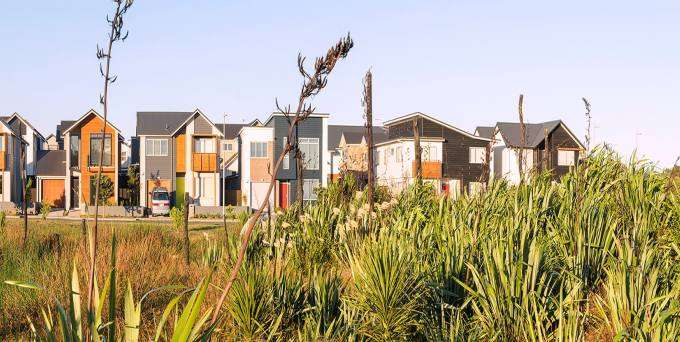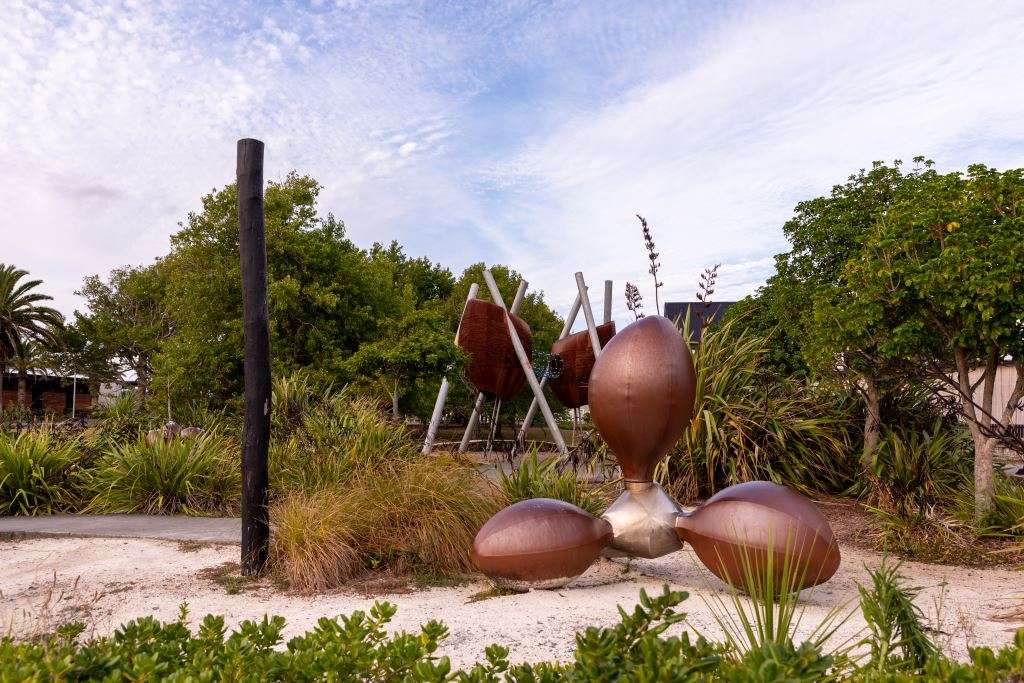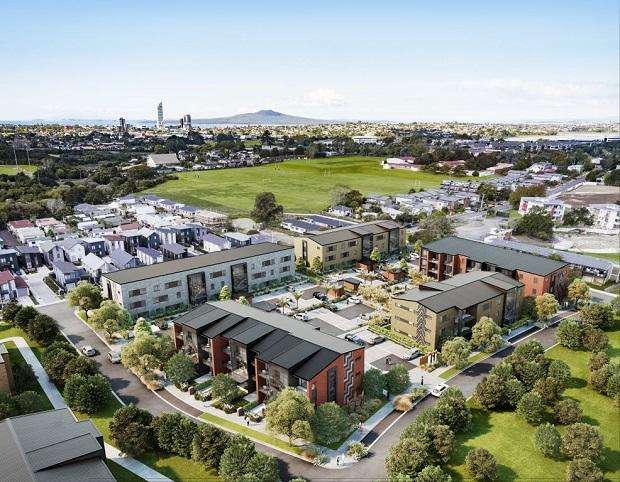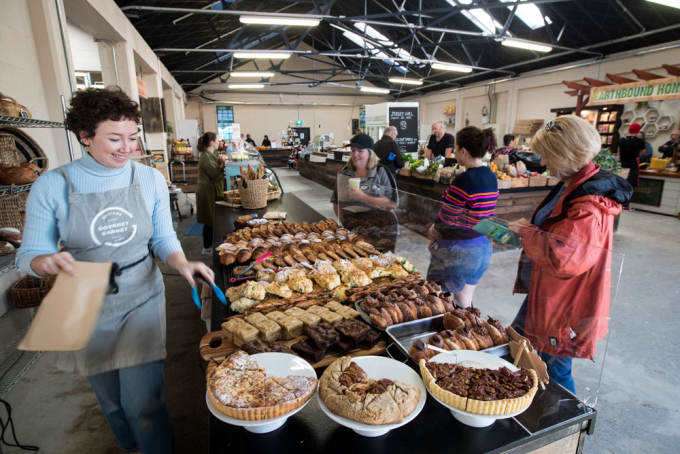Well-designed homes in master-planned communities are proving an attractive proposition not only in terms of resale values but also as a way to prevent social isolation among those who live there.
James Wilson, from OneRoof’s data partner Valocity, says Hobsonville Point in the west of Auckland and Stonefields in the east are leading the way with values leaping up – the median difference in sale value over the last six years for Stonefields was $296,500 and $87,981 for Hobsonville Point.
READ MORE: Find out if your suburb is rising or falling
Some people who held their property at Stonefields for the relatively short time period of 3 to 7 years made profits of between $300,000 and $400,00 when they sold, Wilson says.
Start your property search
Part of the attraction is the design of these new communities which incorporate schools, parks, cafes and other amenities right on people’s doorsteps.
Master-planned suburbs in large urban cities are becoming more prevalent, Wilson says, with the traditional aspiration for a quarter acre section giving way to aspiration a smaller back yard and pleasant, shared space.
Developers go wrong when they try to cram in too many homes, favouring another house over green space, and locations with good public transport links are also key in sustaining values.
And because New Zealanders like a bit of “uniqueness” it’s important not to build thousands of identical houses, Wilson says.

Station St, one of the first streets to be developed at Hobsonville Point. Photo / Supplied
“The developments that get it right get a good mix so they get some smaller apartment stock for your entry level first home buyer and larger homes for the family market, and they get the retiree market.
“In doing that they not only make the development look and feel more like a suburb, they also start protecting those longer-term resale values and trends for those that buy in.”
Template for success
Hobsonville Point had different developers for different zones and specific requirements about the housing mix and has proven a great case study of how to succeed, compared to a suburb without good public transport links which might get more cars parked on the streets and on curbs.
Hobsonville Point has the ferry, buses and cycleways and there is adequate parking and Stonefields, similar to Hobsonville Point but on a smaller scale, has a thoughtful mix of housing and public amenities and now has a bus route into the suburb, plus it’s on the fringe of some popular Auckland suburbs.
“As a result it wasn’t just popular when it was first sold, it’s maintained its popularity and you see that in some of the profits people are making.”

One of the parks created to foster community spirit in Hobsonville Point. Photo / Supplied
Ian Little, associate director of research for Colliers, says Hobsonville Point has set a template for large scale new developments.
The quality of the housing build was given priority meaning houses are warmer, drier and more energy efficient than some other existing stock. “The trade-off is you’re living in a more intensive community but certainly those better-designed homes have driven a bit of an uptick in values.”
Little says a case in point is the sale of two terrace houses on Hobsonville Point Road only four doors from each other and of the same size.
“One sold in 2015 for $485,000 and the other sold a couple of months ago for $800,000, so that’s a 65 per cent increase in value for what appear to be exactly the same property over a five year period.”
Good capital gain
The apartment market is following a similar trajectory for strong resale values in better designed buildings over poorer quality design.
Little says the last generation of “shoebox” apartments of only 20 or 30sq m in Auckland’s CBD in the 2000s were designed for the investor market and while rental returns were good capital gain has not been so impressive.
“If you look at average values of what was selling for 10 years ago your capital gain has probably been $210,000 or $215,000 whereas housing in the Auckland region you’re up at nearly $450,000, and if you take the rest of the apartment stock across the Auckland region it’s a $365,000 increase.
“You can see the rest of the market has out-performed those rather poorly-designed older apartments in town.”

Kainga Ora's development in Northcote brings the walkability and density of older Auckland suburbs to a neighbourhood regeneration. Photo / Supplied
More recent developments in inner city suburbs have been aimed at owner-occupiers and the apartments are larger with better design quality and often with shared facilities like gyms and swimming pools which have driven higher values.
For Kainga Ora good design is all about generating a sense of community and belonging. Kainga Ora’s affordable housing programme has run throughout Hobsonville Point’s development with its series of Axis homes which are aligned with the KiwiBuild price points of between $450,000 to $650,000.
Sense of community
Hayley Fitchett, head of urban design, says these homes are pepper-potted throughout each block with discussions taking place with architects and developers to ensure a community is created without social isolation.
A recent survey of residents found 96 per cent of respondents found the area a great place to live, with people liking the friendliness, the neighbours and the sense of community, and also the parks, reserves and green spaces.
The sense of community comes down to how the development is planned. In Kainga Ora’s design guidelines, for example, there is a requirement for people to have an active, habitable space fronting the street and only a low fence which leads to more likelihood of people saying hello to each other and forming a social network.
“All those little things build up the ties that bind us together in a really positive way to make a community and, therefore, stop us from feeling isolated or lonely, that no one knows me, no one understands me, no one sees me.”
Lot’s of “bump spaces” are built into the different blocks where people can gather and meet and learnings such as this are being utilised in other areas of the Auckland Housing Programme, like Roskill where the community isn’t being created but strengthened.
The goal of Kainga Ora is to create neighbourhoods which are “friendly by design” and when the Roskill community raised the safety of children walking to school one solution was to create a “play street” along the way.
“This street will have opportunities for natural play, places where people can gather and keep an eye on the kids and make sure they can cross the road safety. It means the street is much more about place – it has a place function rather than just a movement function.”

Hobsonville Point's Farmers Market, opened in early 2011, attracts crowds from across Auckland. Photo / New Zealand Herald
Friendly by design looks to co-create communities which are safe, healthy, inclusive and well-connected, she says.
“It’s a new approach to urban development that seeks to address wider societal problems, such as, loneliness and isolation, safety and accessibility.
Barefoot neighbourhood
“For example, having a porch area and low fence allows elderly people to sit in the sun and watch neighbours pass by, providing opportunities for social interaction.”
Orienting homes correctly means parents can see children playing outside or over in the park and Kainga Ora is trying to create a new version of the “barefoot neighbourhood” for children, she says.
“Rather than one kid on their own in their backyard kicking a ball around, there’s a communal space where kids can get together to run around and families can gather for a birthday party or barbeque.”
At Hobsonville Point, the master-planning is so successful people often don’t want to leave, says Mike Pero real estate agent Graham McIntyre.
The strong resale value means people can invest their profit into buying a bigger house nearby.
“That’s the benefit of Hobsonville Point – it offers a whole raft of levels of investment. You can look at a two-bedroom apartment at $500,000 through to the top end of swanky at $2m. Even the tenanting population tend to then look at buying in the area so there is a strength of community in there – maybe that’s the secret ingredient for why people stay there.”
















































































